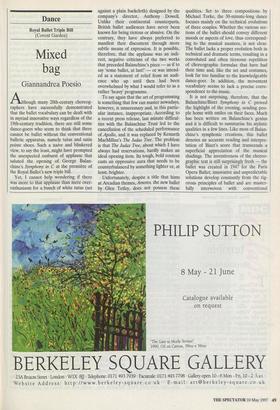Dance
Royal Ballet Triple Bill (Covent Garden)
Mixed bag
thannandrea Poesio
Athough many 20th-century choreog- raphers have successfully demonstrated that the ballet vocabulary can be dealt with in myriad innovative ways regardless of the 19th-century tradition, there are still some dance-goers who seem to think that there cannot be ballet without the conventional balletic apparatus, namely tutus and satin pointe shoes. Such a naive and blinkered view, to say the least, might have prompted the unexpected outburst of applause that saluted the opening of George Balan- chine's Symphony in C at the premiere of the Royal Ballet's new triple bill.
Yet, I cannot help wondering if there was more to that applause than mere over- enthusiasm for a bunch of white tutus (set against a plain backcloth) designed by the company's director, Anthony Dowell. Unlike their continental counterparts, British ballet audiences have never been known for being riotous or abusive. On the contrary, they have always preferred to manifest their discontent through more subtle means of expression. It is possible, therefore, that the applause was an indi- rect, negative criticism of the two works that preceded Balanchine's piece — as if to say 'some ballet, at last!' — or was intend- ed as a statement of relief from an audi- ence who up until then had been overwhelmed by what I would refer to as a rather 'heavy' programme.
To say again that the art of programming is something that few can master nowadays, however, is unnecessary and, in this partic- ular instance, inappropriate. According to a recent press release, last minute difficul- ties with the Balanchine Trust led to the cancellation of the scheduled performance of Apollo, and it was replaced by Kenneth MacMillan's The Judas Tree. The problem is that The Judas Tree, about which I have always had reservations, hardly makes an ideal opening item. Its tough, bold content casts an oppressive aura that needs to be counterbalanced by something lighter or, at least, brighter. Unfortunately, despite a title that hints at Arcadian themes, Amores, the new ballet by Glen Tetley, does not possess these qualities. Set to three compositions by Michael Torke, the 30-minute-long dance focuses mainly on the technical evolutions of three couples. Whether the various sec- tions of the ballet should convey different moods or aspects of love, thus correspond- ing to the musical nuances, is not clear. The ballet lacks a proper evolution both in technical and dramatic terms, resulting in a convoluted and often tiresome repetition of choreographic formulae that have had their time and, like the set and costumes, look far too familiar to the knowledgeable dance-goer. In addition, the movement vocabulary seems to lack a precise corre- spondence to the music.
It is not surprising, therefore, that the Balanchine/Bizet Symphony in C proved the highlight of the evening, sending peo- ple home with smiles on their faces. Much has been written on Balanchine's genius and it is difficult to summarise his stylistic qualities in a few lines. Like most of Balan- chine's symphonic creations, this ballet denotes an accurate reading and interpre- tation of Bizet's score that transcends a superficial appreciation of the musical shadings. The inventiveness of the choreo- graphic text is still surprisingly fresh — the ballet was created in 1947 for the Paris Opera Ballet; innovative and unpredictable solutions develop constantly from the rig- orous principles of ballet and are master- fully interwoven with conventional solutions which, in turn, mirror the chore- ographer's profound respect for the classi- cal tradition. I only wish that the dancing of the corps de ballet had been more in uni- son — a fundamental prerequisite for any Balanchine work — and that the white tutus mentioned above were slightly revised for they do not render a great service to the dancers' bodies.
The whole evening, though, was a good occasion for appreciating the talents of the principal dancers. While Darcey Busse11 is the ideal Balanchinian interpreter, Debo- rah Bull is the perfect example of a dancer who knows how to respond to different stylistic requirements. Gillian Revie was perfectly at ease as The Woman in The Judas Tree, a role on which she managed to confer an interesting, personal reading. The male contingent — Irek Mukhamedov, Christopher Saunders, Bruce Samson, William Trevitt, Stuart Cassidy, Tetsuya Kumakawa and Michael Nunn — was at its best too. Pity about the context, for a less uneven programme would have given more chances to appreciate better the talents of these dancers, artists the company should be proud of.



































































 Previous page
Previous page